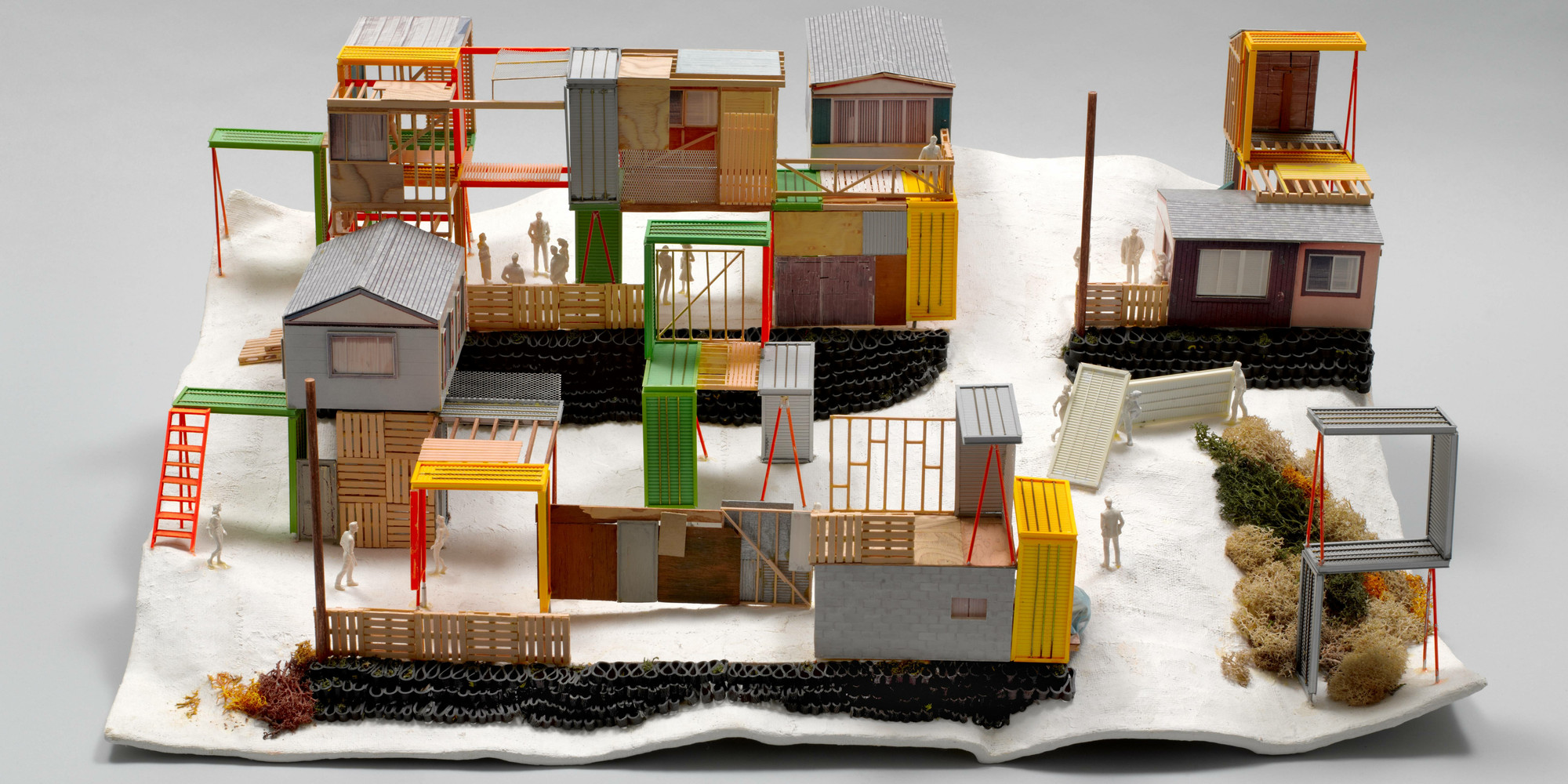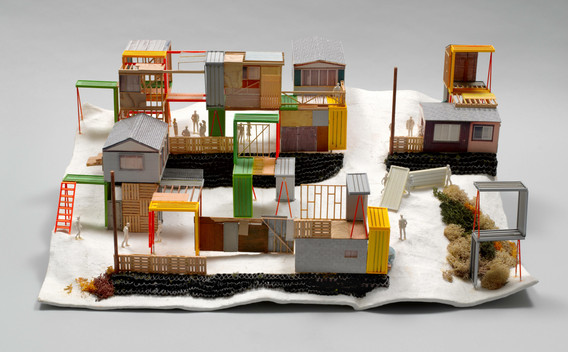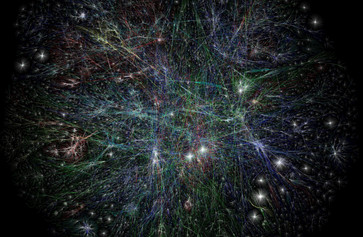
Ten Minutes with Teddy Cruz and Fonna Forman: On Building Citizenship
Discover how architecture can unite communities divided by an international border.
Fonna Forman, Teddy Cruz
Jan 27, 2023
With less than 20 miles between them, the cities of San Diego, California, and Tijuana, Mexico, have more in common than one might think. As political theorist Fonna Forman puts it, “If you imagine the region without that border there, what you’d see is a culture shared between these two cities.” This idea is at the core of Manufactured Sites, an architectural project currently on view in MoMA’s Gallery 216: Systems.
Developed with architect and visual artist Teddy Cruz, Manufactured Sites is the product of 10 years of research into the flow of material waste between these cities. Tires, garage doors, and even entire homes make their way from San Diego to Tijuana, where migrants seeking entry into the United States reconfigure the parts into emergency housing. But the project doesn’t stop there—it also presents new possibilities for safer emergency housing.
“We cannot leave institutions off the hook,” says Cruz. “We negotiated with those factories, because we wanted to make them accountable for the fact that many of their workers lack housing, and they could, in fact, redirect the resources to support them.” In this month’s Ten-Minutes podcast, we’ll hear from Cruz and Forman about the ways communities can collaborate across international borders and the possibility of creating a safe home for everyone.
To hear more about Manufactured Sites and the ways it rethinks citizenship, borders, and community, click on the SoundCloud audio below.

Teddy Cruz, Fonna Forman. Manufactured Sites: A Housing Urbanism Made of Waste/Maquiladora. Project 2005–08; model 2005
Below is a transcript of the SoundCloud audio.
Teddy Cruz: Our border region really is a microcosm of all the injustices committed on vulnerable people across the world: unprecedented socioeconomic inequality, a dramatic migration of peoples, the impact of climate change everywhere, the challenges of urbanization everywhere. At this border, we can rethink many of those conditions. And one of them, which is fundamental for our work, is the rethinking of citizenship.
Fonna Forman: You know, we live in a region where the idea of citizenship divides people, and people align with national identity and the documents that they carry in their pockets. These racist political narratives in the US characterize the border region as a zone of rupture and closure. And one of the things we’ve been trying to do in our work is to document the flows and circulations that unite people on both sides of the wall.
Fonna Forman: I’m Fonna Forman. I’m a political theorist and I teach at the University of California, San Diego.
Teddy Cruz: I’m Teddy Cruz. I’m an architect and visual artist. And with Fonna Forman, we lead an architectural and civic practice dedicated to the border region between Tijuana and San Diego.
Fonna Forman: So San Diego and Tijuana are sister cities. They sit side by side, but these two cities are pretty divided by an international border. This is a region of dramatic disparities between rich and poor, different labor cultures. This is a zone with an amazing capacity to absorb new arrivals that are traveling north from Central America, seeking access to the US, but being denied entry. The inability to house all of these arriving migrants, from Central America, from Haiti, even now from Ukraine, has created a pretty deep housing crisis.
Teddy Cruz: These communities cannot build themselves in the same way that many neighborhoods in the United States happen: with a lot of resources in the beginning, a lot of support infrastructure. They come in, these communities, to create very precarious environments, and then incrementally through years, their municipality begins to send them infrastructure.
Fonna Forman: People in Tijuana are building their houses out of recycled materials that they find around them, and surrounding these informal areas are maquiladoras or factories. The people that build these houses actually work in the factories where these material systems come from.
One of the ways we’ve been trying to respond to this housing crisis is by negotiating with local factories and the private sector to invest in social housing in Tijuana, and Manufactured Sites is an example that we started many years ago.
Teddy Cruz: We built a model in response to our observation of how informal settlements in Tijuana are actually built with the waste of San Diego.
San Diego is a car-centric city. A lot of the rubber tires that are disposed of end up in Tijuana and people recycle them to create infrastructure in these precarious environments. Garage doors from the houses that are being demolished in the older suburbs of San Diego end up in Tijuana to create new walls that actually enable these informal buildings to have a safe skin. Entire houses, in fact, from San Diego are transferred into Tijuana and recycled to construct new, fresh narratives, new environments for people to live in.
Fonna Forman: When people are in conditions of scarcity and danger, they assemble housing from whatever they can find around them, whether it’s recycled tires or recycled garage doors or different sorts of construction debris, they assemble a house.
Teddy Cruz: So what you see, effectively, is a model that incorporates some of this waste that is given a second life. architecture that is made of parts that are recombined through the agency of people building their own environments.
Fonna Forman: In the formal system of architecture this kind of assemblage is understood as a symbol of poverty, a symbol of deprivation, a symbol of what we don’t want our cities to look like, but Teddy and I have found incredible resilience and creativity in these building practices.
Teddy Cruz: We have always been inspired by immigrants as they move into the United States and build their own forms of housing with their own resources and their own creative intelligence.
We don’t want just to stop there. We want to also we want to celebrate the creative intelligence, so that we can increase that capacity. So we have been working with factories that surround these environments to provide frameworks—in fact, prefabricated metal frames—to support that recycling of waste.
Fonna Forman: For us, this is hugely inspiring, because formal planning typically doesn’t make space for this speculative kind of adaptation, and these informal communities do that by necessity. Often, when we have told institutions about this creative intelligence, they might suggest, “Well, if they’re so creative, maybe they can do it on their own.” And part of our investigation has been that we cannot leave institutions off the hook. We need to make those institutions accountable. Industry, civic, philanthropy, cultural institutions, universities—they need to redistribute their own resources in order to support that creative intelligence from below.
Teddy Cruz: So that’s the reason we negotiated with those factories, because we wanted to make them accountable for the fact that many of their workers lack housing, and they could, in fact, redirect the resources to support them.
Fonna Forman: One of the things that really differentiates our project from other housing projects in the humanitarian space is we’re not descending down and building houses for migrants. which is the typical humanitarian response to housing. And what we’ve been trying to do with a project like this is demonstrate a way of collaborating to assemble housing together where the capacities of the migrants themselves are an important part of the equation. And we’ve always seen this as a more respectful and dignified way to engage the problem.
Teddy Cruz: And that’s where the designers, that’s where the architects, come in, as facilitators of new institutional collaborations in support of community. At some point we were in a meeting when somebody asked us, who are you to say that these people like to live surrounded by trash? The person asked us, if you were to ask them, would you like to live in a San Diego house, in one of those McMansions, probably they would love to live there. And of course the person is right. But what came to our mind at that very moment was, while that is true, what do we do in the meantime? When would that person move to a San Diego house or to a safer environment, in two years, in five years, in 60 years? So this is where we began to think of the necessity for infrastructures that support transition.
Fonna Forman: When the migrant arrives, the first urgent moment is a humanitarian moment, a moment of taking care of urgent needs of the body and medicine and shelter and all of this. But when thinking about the longer term sort of prospect of migrants arriving in a host city, it’s more about thinking about durable solutions that involve the migrant in the definition of the problem and the creation of the solutions.
Teddy Cruz: We always dismiss and ignore the sweat equity of immigrants and the value of their labor, and this project is trying to absorb that labor to mean something, to be recognized in the context of urban development.
Fonna Forman: One of the things that we’ve tried to amplify about life in this region is that it’s basically a mega city of 7 million people divided artificially by a wall.
Teddy Cruz: In these environments, people recycle materials from San Diego—garage doors, rubber tires, small post-war houses—and they are brought into these environments and they are recombined.
Fonna Forman: It’s a political economy of cooperation where one city is importing the sort of recycled materials from another. For us, this is an indication of citizenship. These are citizens working together for the sustainability and mutual benefit of housing in the region.
Teddy Cruz: We want to reimagine citizenship as organized by the shared values, common interests of communities that have been splintered and divided because of the imposition of political or economic policies.
Fonna Forman: Poverty and political instability now and climate change. These are not issues that affect only Tijuana or only San Diego. We are a bioregion, and all of these flows affect all of us. If you imagine the region without that border there, what you’d see is a culture shared between these two cities—aspirations and, sort of, dreams and hopes that are shared between these two cities. But the border, you know, serves as a kind of a rupture in this territory. So one of the things that we like to do is to imagine what the region looks like without this wall that divides us.
Teddy Cruz: Creating opportunities, imagining the world in a better way, this is what motivates people in conditions of emergency. You have to build something out of nothing, so all of a sudden you begin to build your own house and you make that house respond to your dreams, to your imagination, to your aspirations. This is what is happening inside this types of spaces. People are building their dreams.
Teddy Cruz is a professor of public culture and urbanism in the department of visual arts at the University of California, San Diego. Fonna Forman (PhD) is a professor of political theory and the founding director of the Center on Global Justice at the University of California, San Diego. Together, they are principals in Estudio Teddy Cruz + Fonna Forman, a research-based political and architectural practice in San Diego investigating issues of informal urbanization, civic infrastructure, and public culture, with a special emphasis on Latin American cities.
This episode was produced, edited, and sound-designed by Arlette Hernandez.
MoMA Audio is supported by Bloomberg Philanthropies.
Related articles
-

Magazine Podcast
Ten Minutes with Kalpona Akter: On Fast Fashion
In Bangladesh, a garment worker barely makes enough money to cover the cost of rent. Discover the truth about the unfair labor practices behind many of the clothes we wear.
Kalpona Akter
Dec 13, 2022
-

Magazine Podcast
Ten Minutes with Tricia Wang: On Web3
A tech ethnographer explains some key terms and ideas behind the future of the Internet.
Tricia Wang
Nov 15, 2022

